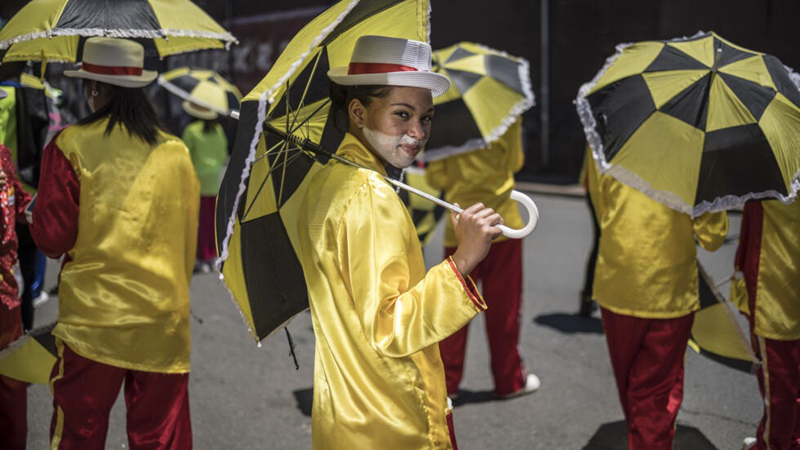
A small boy in a torn T-shirt takes in the sunny scene, eyes wide open and fists on his hips. He was one of several children following the parade, unsupervised and fascinated by the festivities in the gritty neighbourhood.
But unlike the traditional minstrel parades in South Africa, this procession was joined by some of the poorest of the poor – the “recyclers” who rummage through garbage in hopes of finding something that will earn a few pennies.
The display, titled “No Man’s Land”, was a creation of “The Centre for the Less Good Ideas”, co-founded by William Kentridge, a South African artist famous for his drawings and animated films.
The bushy-browed 68-year-old is present, wearing his customary white shirt and Panama hat, amusedly observing the hustle and bustle, the whistles and shouts.
It was choreographer and dancer Sello Pesa who came up with the idea of the carnival procession to celebrate the tenth season for the centre, whose headquarters are in the Maboneng district – the depressed centre of South Africa’s economic capital. The artists got ready in the courtyard of this former industrial complex, made up of small brick buildings now housing performance halls and workshops.
For the parade, Pesa enlisted the recyclers, who normally focus on searching for items like cardboard, scrap metal and plastics to earn a meagre living.
“My idea is to look at ignored societies that feed art, exploring how they can meet in public space. To bring what is thrown away into a pristine, posh area,” the trained dancer said.
“Last time there were Congolese men who work as security guards or parking attendants in the street. This time the recyclers mostly come from Lesotho,” he said.
“I meet them on the street, when I park my car. They tell me their stories.”
Garbage dress
Suddenly, a fairy appears in a stunning hand-sewn dress, evoking the fluorescent vests worn by garbage collectors, extended by a plastic skirt covered with empty bottles – milk, deodorant, toiletries – and crumpled paper.
It’s as if the contents of a garbage can had been poured over her head. “This is what the planet is going through. It’s hot under my skirt. Like the planet,” the dancer, 39-year-old Teresa Phuti Mojela, tells AFP. She taps a fork on a wine glass, getting everyone’s attention as she signals the start of the fanfare.
The garbage scavengers sing a cappella, clapping their hands, using inflated bags as percussion and boomboxing with their mouths. Residents, passers-by and other onlookers raise a cheer as the band takes to the streets, marching behind a pickup truck loaded with a loudspeaker.
At the front, a feather-capped minstrel rolls his eyes and grimaces to amuse the children. He throws his stick in the air, deftly retrieves it and sways to the beat. The scene is reminiscent of a Mardi Gras parade in New Orleans. A wave of energy and noisy joy threads its way through the poor, ramshackle and often dangerous streets.
Several police cars flank the mad procession as it passes small grocery stores and braziers of grilled meat on the sidewalk. A fleeting look of joy crosses the faces of the crowd, who take a moment’s pause from their everyday lives.


